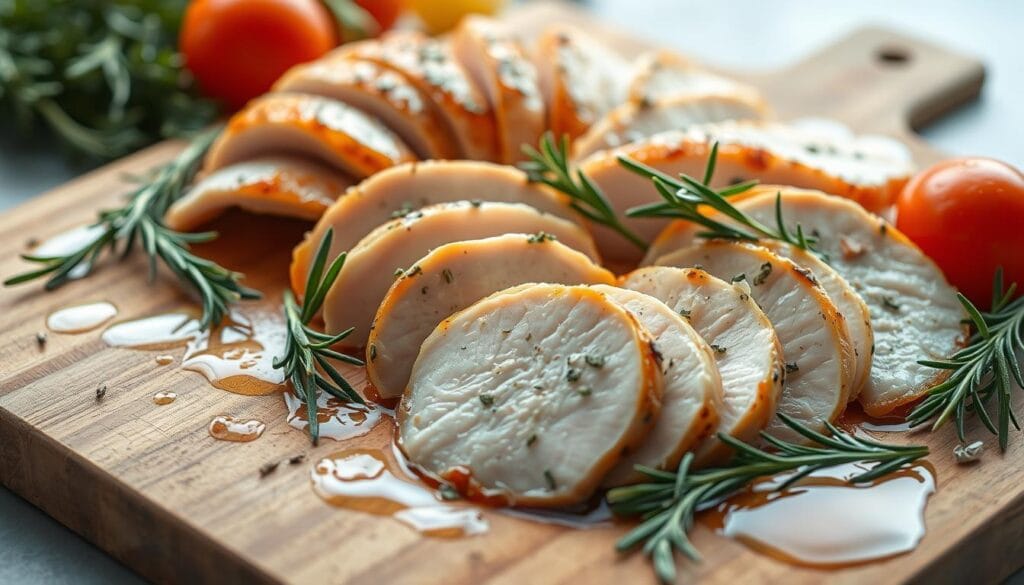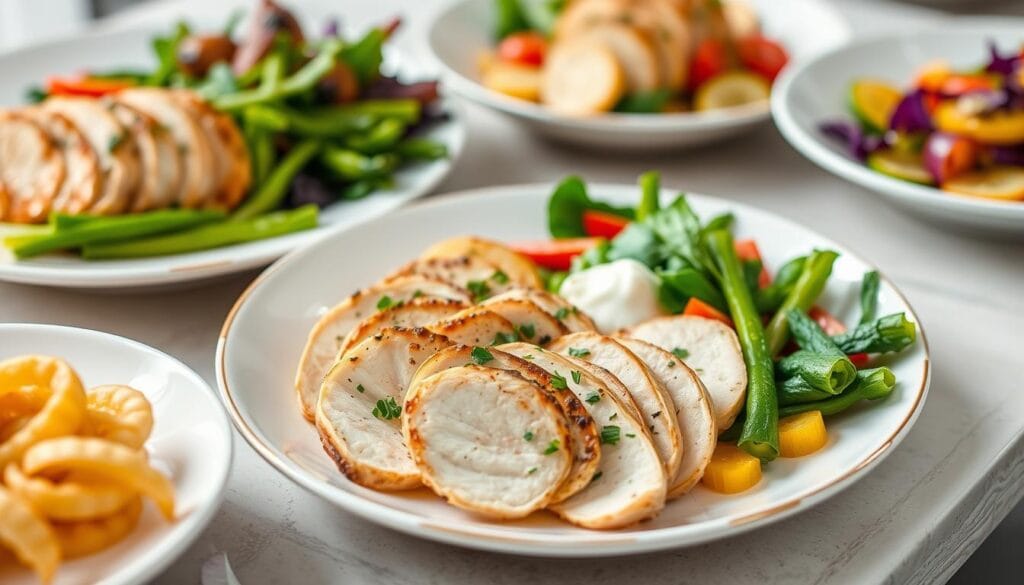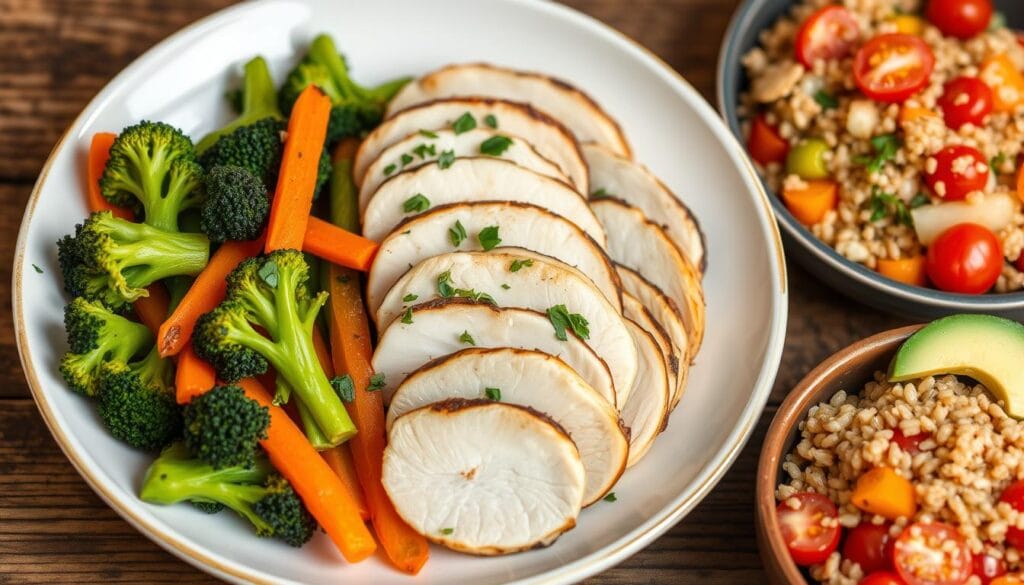How to Cook thin Chicken breast recipes for Tender Results Every Time
As a busy parent, finding quick, healthy meals is a challenge. Thin sliced chicken breasts are a go-to in my home. They’re nutritious, versatile, and cook fast. In this guide, I’ll share my tips for tender chicken every time.
Cooking thin sliced chicken breasts is key for quick dinners or meal prep. With the right methods, you’ll make moist, tasty chicken. Your family will love it.

We’ll explore brining and baking to cook chicken perfectly. Bid farewell to dry chicken and welcome tender, juicy meat instead. Let’s discover the secrets to thin chicken breast recipes, healthy chicken recipes, and low-fat chicken dishes that will delight your taste buds.
Table of Contents
Understanding Thin Sliced Chicken Breasts: Benefits and Basics
Thin sliced chicken breasts are great for lean protein meals and weight loss recipes. They cook fast, soak up flavors well, and cook evenly. This makes them a top choice for health-focused cooks.
Why Choose Thin-Sliced Over Regular Chicken Breasts
Thin sliced chicken breasts cook faster than regular ones. This means your meals are ready quicker. They also get more flavor from marinades and seasonings, making each bite taste better.
Nutritional Benefits of Lean Chicken
Chicken breast is packed with lean protein. A 3-ounce serving of grilled, skinless chicken breast has 26 grams of protein. It has only 2.7 grams of fat and no carbs, with just 128 calories. This makes thin sliced chicken breasts perfect for healthy meals.
Essential Kitchen Tools for Perfect Results
- A sharp chef’s knife for effortless slicing
- A meat mallet to ensure even thickness
- A reliable meat thermometer for perfectly cooked chicken
With the right tools and techniques, you can make tender, juicy thin-sliced chicken breasts. They’re great for lean protein meals, diet-friendly dishes, or weight loss recipes.
The Secret to Perfectly Tender Chicken: Brining Method
Making juicy, flavorful chicken breasts is simpler than you think. The trick is a simple brining process. It keeps moisture in and boosts flavor from the inside out. Just mix 1/4 cup of salt in 4 cups of warm water and soak your skinny chicken breasts for 15 minutes. This turns regular chicken into a high-protein low-calorie meal full of taste.
The brine recipe tested used 4 cups of cold tap water and different amounts of salt. For example, 6 tablespoons of Diamond Crystal kosher salt, 4 1/2 tablespoons of Morton’s kosher salt, or 3 tablespoons of fine or table salt. Using warm tap water made the chicken less tender and juicy than cold water.
The best brining time for chicken breasts is 30 minutes to one hour. Brining for 60 minutes made the chicken perfectly seasoned, juicy, and tender. But brining for 2 hours made it too salty. After brining, rinse and pat the chicken dry for the best taste.
| Brining Time | Tenderness and Juiciness |
|---|---|
| 30 minutes | Good |
| 60 minutes | Excellent |
| 120 minutes | Slightly Oversalted |
Brining makes chicken juicier, more tender, and flavorful. It adds moisture, changes the texture, and seasons the meat inside. Testing showed a 53% drop in dryness and flavorlessness, with 977 perfect grills.
Don’t accept dry, tasteless chicken breasts. Use brining to make your chicken tender and high-protein low-calorie meals every time. Both your taste buds and waistline will thank you.
How to Slice Chicken Breasts Properly
To get the best texture and cooking results for your chicken dishes, start with the right slice. Thin slices cook faster and cook more evenly. This makes your nutritious chicken breast preparations tender and juicy. Here’s how to slice chicken breasts with precision.
Step-by-Step Slicing Technique
- Place the chicken breast on a clean cutting board. Let it sit at room temperature for about an hour before you slice.
- Cut the chicken horizontally using a sharp knife. Make slices that are 1/2 to 3/4 inch thick. Press gently and move steadily for clean cuts.
- Pay attention to the meat’s grain as you slice. Cutting against the grain makes the slices tender and juicy.
Achieving Uniform Thickness
It’s important to have slices of the same thickness for even cooking. If some slices are thicker, use a meat mallet or the flat side of a knife to pound them thinner. This ensures all slices cook evenly, preventing over or undercooking.
Common Cutting Mistakes to Avoid
- Slicing with the grain: This makes the chicken tough and chewy.
- Creating uneven thickness: Uneven slices cook at different times and have different textures.
- Pressing too hard while slicing: This can tear or misshape the chicken.
- Using a dull knife: A sharp knife is needed for clean, precise cuts.
By using these simple techniques, you can easily slice your chicken breasts. This ensures your fitness-oriented chicken dishes are tender, juicy, and evenly cooked every time.
“Thinly sliced chicken breasts are a kitchen game-changer, offering faster cooking times and more consistent results.”
Essential Seasonings and Marinades for Thin Chicken Breast Recipes
Unlock the full flavor of your thin chicken breast recipes with the right seasonings and marinades. A flavorful wet rub can tenderize and season your chicken. Mix garlic powder, onion powder, chili powder, paprika, dried rosemary, salt, lemon juice, and olive oil for a vibrant marinade.
This blend adds depth of flavor and keeps the chicken moist and juicy. Use a fork to pierce the chicken, allowing the marinade to absorb. Marinate for at least 15 minutes, or up to 48 hours for the best taste and tenderness.
The marinade has three key parts: oil, acid, and flavorings. The oil helps the seasonings stick, the acid tenderizes, and the herbs and spices add flavor. This marinade makes your tender, flavorful thin chicken breast recipes a hit every time.
- Garlic powder
- Onion powder
- Chili powder
- Paprika
- Dried rosemary
- Salt
- Lemon juice
- Olive oil
You can also freeze the chicken with the marinade for up to 3 months. Just thaw it in the fridge and bake or grill as usual. This makes meal prep easy and ensures your healthy chicken recipes are always ready.
“The flavors in this marinade are simply perfect! My family raves about these juicy, tender chicken breasts every time.”
Perfect Temperature and Timing Guide
Cooking low-fat chicken dishes and lean protein meals needs precision. This ensures tender, juicy results every time. Baking thin sliced chicken breasts requires knowing the best oven settings and cooking times.
Optimal Oven Settings
For the best results, preheat your oven to 450°F (230°C). This high heat sears the chicken’s outside. It helps keep the inside moist and tender.
Cooking Duration Guidelines
Thin sliced chicken breasts bake in 12-15 minutes at 450°F. Watch them closely, as they can overcook fast. Use a meat thermometer to check if they’re done. The USDA says chicken should be at 165°F (74°C) for safety.
Using Meat Thermometer Effectively
A good meat thermometer is key for perfect chicken. You can choose from an instant-read model for $14 or a dual-probe wireless one for $33. Insert the thermometer into the thickest part of the breast, making sure to avoid any bones. When it hits 165°F (74°C), take the chicken out and let it rest for 5 minutes. This results in moist and tender chicken.
| Thermometer Type | Price |
|---|---|
| Instant-read Cooking Thermometer | $14 |
| Dual-probe Wireless Meat Thermometer | $33 |
By sticking to these temperature and timing tips, you’ll always get perfectly cooked chicken. This is great for your low-fat chicken dishes and lean protein meals.
Best Cooking Methods for Juicy Results
Choosing the right cooking method is key to tender, juicy chicken breasts. Baking the chicken at a high temperature of 450°F (230°C) for 20-25 minutes works well. This method seals in moisture, making the chicken perfect for a healthy meal.
Pan-searing the chicken over medium-high heat for 3-4 minutes per side is another great option. It gives a golden-brown outside and a juicy inside. For a smoky taste, grilling the chicken for 4-5 minutes per side is ideal.
It’s important to avoid overcooking the chicken. Overcooked chicken can be dry and tough. Use a meat thermometer to check the chicken’s internal temperature. It should be 165°F (74°C) before you take it off the heat.
Learning these cooking techniques will help you make tender, juicy chicken. It’s perfect for your weight loss recipes and meal plans.
| Cooking Method | Time | Temperature | Tips |
|---|---|---|---|
| Baking | 20-25 minutes | 450°F (230°C) | Cover the baking pan with foil to seal in moisture. |
| Pan-Searing | 3-4 minutes per side | Medium-High Heat | Achieve a delightfully golden-brown exterior. |
| Grilling | 4-5 minutes per side | Medium-High Heat | Enjoy the smoky, grilled flavor. |

“The secret to perfectly cooked thin-sliced chicken breasts is to avoid overcooking and preserve their natural juiciness.”
Storage and Meal Prep Tips
Cooking a batch of juicy, high-protein meals with thin sliced chicken breasts is great for busy weekdays. Learning how to store and prep these cuts keeps your meals fresh and tasty.
Proper Storage Methods
After cooking, store your chicken in airtight containers in the fridge for up to 4 days. For longer storage, freeze cooked chicken for up to 3 months. Freezing in individual portions makes reheating easy.
Reheating Guidelines
To reheat, place chicken in the microwave in 15-second bursts, stirring between each interval. This method keeps the meat moist. You can also reheat in a skillet with a bit of broth or water.
Batch Cooking Strategies
- Make multiple servings of chicken at once for easy week-long meals.
- Marinate or season chicken ahead, then freeze for quick meals.
- Cook a big batch in the oven or air fryer, then portion into containers for prep.
With a bit of planning and these tips, you’ll always have ready-to-eat, high-protein meals.
Serving Suggestions and Pairing Ideas
Mastering the art of cooking tender, juicy thin-sliced chicken breasts opens up endless possibilities. You can serve your perfectly cooked chicken with various side dishes. This creates well-rounded, fitness-oriented chicken dishes.
For a light meal, pair the thin chicken breast preparations with a fresh salad. Try a quinoa pumpkin salad or a balsamic quinoa salad. The lean protein from the chicken breasts complements the nutrient-dense greens and grains. This makes for a satisfying and nutritious chicken breast dish.
You can also add the thin-sliced chicken breasts to pasta dishes for a heartier meal. An Italian-inspired pasta salad with the fitness-oriented chicken dishes is a delightful and complete meal.
Remember to use leftover thin chicken breast preparations in creative ways. Try them in wraps, sandwiches, or as a protein boost for soups and stews. The versatility of these tender, juicy chicken breasts lets you enjoy them in many nutritious chicken breast dishes throughout the week.
“The key to crafting delicious and satisfying meals with thin-sliced chicken breasts is to pair them with complementary flavors and textures that elevate the overall dining experience.”
Incorporating these fitness-oriented chicken dishes into your weekly meal planning is beneficial. You get to enjoy lean, protein-packed chicken while trying different nutritious chicken breast preparations. These are both delicious and nutritious.

Conclusion
Learning to cook thin sliced chicken breasts is a game-changer. It lets you make fast, healthy, and tasty meals. This guide teaches you how to slice, cook, and serve chicken breasts perfectly.
Thin sliced chicken is great for quick stir-fries, crispy cutlets, or healthy salads. These healthy chicken recipes are quick, lean, and easy on your wallet. They’re a smart choice for busy days.
With the tips from this guide, you’ll make low-fat chicken dishes that taste amazing. Thin sliced chicken opens up a world of quick, delicious meals. It’s ideal for you and your family.
FAQ
What are the benefits of cooking with thin sliced chicken breasts?
Thin sliced chicken breasts cook faster and absorb flavors better. They’re great for quick meals and are high in protein but low in fat. This makes them perfect for portion control.
What are the essential kitchen tools needed for cooking thin sliced chicken breasts?
You’ll need a sharp knife for slicing, a meat mallet for even thickness, and a meat thermometer for perfect doneness.
How does brining help create juicy, flavorful chicken?
Brining makes chicken juicy and flavorful. Mix 1/4 cup salt in 4 cups lukewarm water. Soak the chicken for 15 minutes. This retains moisture and enhances flavor.
What is the proper way to slice chicken breasts for even cooking?
Slice chicken breasts horizontally to get 1/2 to 3/4 inch thick pieces. Use a sharp knife and steady hand for even cuts. Pound thicker parts gently for uniform thickness. Avoid slicing with the grain or making uneven pieces.
What is the best way to season and marinate thin chicken breasts?
Mix garlic powder, onion powder, chili powder, paprika, dried rosemary, salt, lemon juice, and olive oil for a flavorful wet rub. Marinate for at least 15 minutes, or overnight for better results. Pierce chicken with a fork to help the marinade penetrate.
What is the optimal oven temperature and cooking time for thin sliced chicken breasts?
Preheat oven to 450°F (230°C) for best results. Bake thin chicken breasts for 12-15 minutes. Use a meat thermometer to ensure an internal temperature of 165°F (74°C).
What are the best cooking methods for juicy, tender thin chicken breasts?
Bake at high temperature (450°F) for a short time, pan-sear for 3-4 minutes per side, or grill for 4-5 minutes per side. All these methods yield juicy results. Avoid overcooking to prevent dryness.
How should cooked thin chicken breasts be stored and reheated?
Store cooked chicken in airtight containers in the refrigerator for up to 5 days or freeze for up to 3 months. Reheat in the microwave in 15-second bursts to prevent drying.
What are some tasty ways to serve thin sliced chicken breasts?
Serve thin sliced chicken breasts with salads, pasta dishes, or roasted vegetables. Try pairing with quinoa pumpkin salad, balsamic quinoa salad, or Italian pasta salad for a complete meal. Use leftover chicken in wraps, sandwiches, or as a protein boost for soups and stews.







